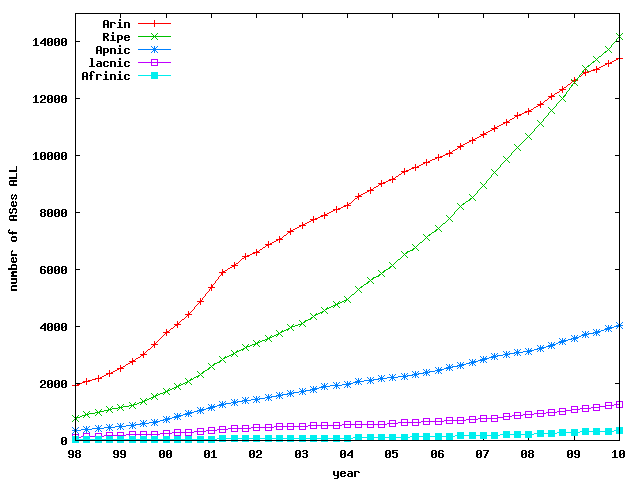Growth trends in the AS-level Internet
May 7th, 2010 by Amogh DhamdhereWe have studied growth trends in the number of ASes seen advertised in the global routing system from different regional registries (similar to Geoff Huston’s 32-bit AS Number Report, but with per-registry trends). We used Routeviews and RIPE BGP dumps over the last 12 years, and Team Cymru’s WHOIS lookup service to map ASNes to registries as of March 2010. To our knowledge, historical data to map an ASN to a regional registry at any given time in the past is not available, so we cannot account for ASN movement between registries. More information about the data collection and pre-processing is in our IMC 2008 paper, “Ten Years in the Evolution of the Internet Ecosystem” and our supplemental data page.
Our most interesting observation is that the two largest registries in terms of the number of advertised ASes (ARIN and RIPE) have shown distinctly different growth trends since 2001. Both registries showed exponential growth until mid-2001, but since then ARIN’s AS count has grown linearly while RIPE’s has continued to grow exponentially, though with a smaller exponent than in the pre-2001 period. The number of advertised ASes allocated from RIPE is now larger than ARIN’s.

We conjecture a couple of possible reasons for the shift. One possible contribution is the presence of companies in Europe that assist enterprises in obtaining Provider Independent (PI) address space and AS numbers. RIPE Labs’ Forum published a recent discussion of this issue. A second, related factor is the inclination of enterprises to seek PI address space (and ASNs) in the first place. The primary objective of enterprises in obtaining an ASN and PI address space is to multihome — connecting to multiple upstream providers for reliability, performance, and other traffic engineering goals. A larger concentration of Internet Exchange Points (IXPs) and more competition in the European transit market could make multihoming more attractive for enterprise customers in Europe than in North America. Measurements in our IMC 2008 paper confirm that the transit market is now larger and more dynamic in Europe than in North America. But we cannot absolutely confirm this theory directly with BGP routing data, since only networks with ASNs show up in BGP, and the majority of customer ASes (both in Europe and North America) are multihomed (otherwise, technically, it should not need an ASN in the first place). It would be illuminating to examine whether enterprise customers that did not request an ASN in North America would have pursued ASN + PI address space if they were in Europe, simply because the competitive transit market in Europe makes multihoming more attractive?
August 24th, 2012 at 9:06 am
Europe was late (compared to America) regarding internet usage
I think that America has reached it’s potential when Europe still don’t